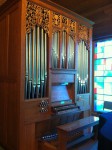
“This Pipe Organ is given to Holy Family Parish in loving memory of Florence M. Antor by the William J. Antor Family”
Pipe organs as we know them today, very small ones, were found as long as one thousand years ago. Simple organs consisted of a small hand-pumped bellows to supply air, a set of carefully constructed pipes, of wood or metal, of suitable size to sound different pitches, and a keyboard and mechanism to admit air into individual pipes. The ancient organ may have only involved a few pipes, two dozen or less. The organs did not produce much volume, but could accompany singing of a solo instrument or small choir. Some organs were described as “portatif” instruments because they were portable, and could be carried along and played on a cart of some kind during processions or parades.
Even as pipe organ design and construction developed over a millennium or more, the Bedient organ in use today at Holy Family still shares a number of traits with the earliest examples of the instrument.
Large church buildings and concert halls are often home to huge pipe organs, which are capable of endless varieties of sound, from very quiet to breathtakingly loud. The Bedient organ contains 16 ranks, or sets of pipes. The largest pipe is approximately 8 feet tall. The largest organ in West Michigan is located in Fountain Street Church in Grand Rapids, and has five manual keyboards (Holy Family’s organ has two), and 145 ranks of pipes. The organ at the Basilica of St. Adalbert has three keyboards and 72 ranks of pipes.
Most organs, such as the Basilica instrument, use electric or electro-pneumatic action, in which wind is admitted to each pipe by means of small, electrically deployed valves. The organist is basically manipulating a set of light switches to cause pipes to sound. Our Bedient instrument uses tracker, or mechanical, action. This method of construction was in use for centuries, until the late 19th Century, and involves a system of slats, of wood, usually, which directly connect the keys with valves, called pallets. When a key is depressed, the valve opens and air is allowed to enter the pipe and cause it to sound. Tracker action is generally considered to be the simplest, most expressive, and longest-lasting type of action.
Pipe organs have been produced in our country in large numbers for some 200 years, but very few new organs are built today. In the past, there were huge factories devoted to constructing pipe organs, from very modest to huge instruments intended for installation in large churches or auditoriums. The Moller Organ Company, of Hagerstown, Maryland, which is no longer in business, produced over 11,000 organs in its 80-year history. There have also been many organs produced by smaller firms. The level of quality control, personal oversight, and attention to the smallest details of the construction process, which is typical of smaller firms, has tended to result in distinctive, first-rate instruments. The Bedient Organ Company, located in Saltillo, Nebraska, was founded by Gene Bedient in the 1970’s. The company has ordinarily employed 10-12 employees, and constructed two or three organs per year. The Holy Family Organ is Opus (Number) 66, and organs have continued to be produced since our organ was installed in summer of 2000. In my opinion, the Holy Family pipe organ is a remarkable example of beauty in sight and sound. Clearly no effort was spared in creating a noble instrument capable of fulfilling its role in song and worship in a Catholic church.
The Bedient organ is a remarkable machine. It is designed and constructed to produce beautiful, musical sound. Most importantly, the organ is intended to support and enhance the prayer and singing of the people who attend and worship at Holy Family Catholic Church. That purpose was firmly in mind when the gift of the organ was first conceived and considered. The instrument came about through study, meetings and compromises, and sometimes troublesome and difficult decision-making…and the generosity of one parishioner and his family. The result is not only a wonderful musical instrument, but a very special work of art, worthy of its role in helping lead and inspire praise of God. The organ, and other instruments, help us leave the outside world and enter our sacred environment, our house of God, Holy Family Church. Let our voices join in song with the rich harmony of the organ pipes, with the guitar and piano and horns and drums. Let all join in singing, Gather Us In, or Praise To the Lord, or Sent Forth By God’s Blessing, and let the organ play its humble but important role in helping us become better people, and more faithful and dedicated Christians, every day.
One artistic detail of Opus 66 deserves special mention. The hand-carved pipe shades depict symbols of our Catholic faith. We also see Jesus, Mary, and Joseph, the Holy Family, and Florence and Bill Antor with their children and grandchildren. The Antors may be seen as representing all the “holy families” who have been baptized, received the Sacraments, and lived in Christ at Holy Family Church, Sparta, Michigan.
“Praise the Lord in his sanctuary, praise him in the firmament of his strength.
Praise him for his mighty deeds, praise him for his sovereign majesty.
Praise him with the blast of the trumpet, praise him with lyre and harp,
Praise him with timbrel and dance, praise him with strings and pipe.
Praise him with sounding cymbals, praise him with clashing cymbals.
Let everything that has breath praise the Lord. Alleluia!” Psalm 150
Richard Hoogterp
Director of Music and Organist
Holy Family Catholic Church
Comments are currently closed.